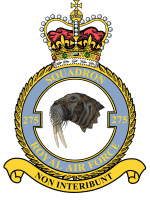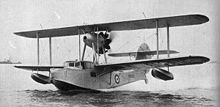
Joint Helicopter Command Flying Station Aldergrove, also known as simply JHC FS Aldergrove, is a British military base located 4.4 miles (7.1 km) south of Antrim, Northern Ireland and 18 miles (29 km) northwest of Belfast, and adjoins Belfast International Airport. It is sometimes referred to simply as Aldergrove which is the name of a nearby hamlet.

No. 202 Squadron of the Royal Air Force is the maritime and mountains training element of the No.1 Flying Training School, operating the Airbus Helicopters H145 Jupiter.
No. 628 Squadron RAF was a meteorological and air-sea rescue squadron of the Royal Air Force during the Second World War.
No. 119 Squadron RAF was a squadron of the Royal Air Force, flying with RAF Coastal Command during the Second World War. It was the only RAF unit flying the Short G class and Short C class flying boats.
No. 282 Squadron was a Royal Air Force air-sea rescue squadron during the Second World War.
No. 281 Squadron was a Royal Air Force air-sea rescue squadron during the Second World War.
No. 280 Squadron was a Royal Air Force air-sea rescue squadron during the Second World War.
No. 283 Squadron was a Royal Air Force squadron that served during the Second World War in the air-sea rescue (ASR) mission role while flying Supermarine Walruses and both in ASR and the anti-submarine patrol role while flying Vickers Warwicks.
No. 284 Squadron was a Royal Air Force squadron.
Royal Air Force Thornaby, or more simply RAF Thornaby, is a former Royal Air Force Station located in the town of Thornaby-on-Tees, in the North Riding of Yorkshire, England. Fighter Command, Bomber Command and Coastal Command all operated from the base over its history, but its stint under Coastal Command is what the base was notable for, particularly in the air-sea rescue environment and the development of the Thornaby Bag. This was an emergency bag dropped to downed aircrew at sea and contained food, cigarettes and drink.
No. 228 Squadron RAF was a squadron of the Royal Air Force active at various times between 1918 and 1964. It spent the greatest part of its existence flying over water, doing so in the First, and Second World Wars and beyond, performing anti-submarine, reconnaissance and air-sea rescue tasks.
No. 293 Squadron was a Royal Air Force air-sea rescue squadron. During the Second World War the unit operated search and rescue missions for Allied aircraft operating over Italy.
No. 294 Squadron was a Royal Air Force air search and rescue (ASR) squadron active under RAF Middle East Command. During the Second World War the unit operated rescue missions for Allied aircraft and aircrew over the eastern Mediterranean and later the Persian Gulf and Arabian sea.

Number 209 Squadron of the British Royal Air Force was originally formed from a nucleus of "Naval Eight" on 1 February 1917 at Saint-Pol-sur-Mer, France, as No. 9 Squadron Royal Naval Air Service (RNAS) and saw active service in both World Wars, the Korean War and in Malaya. The use of the squadron number ceased in 1968 and it has not been reused since by an RAF squadron. However the number, badge and motto is in current service within the RAF Air Cadets at 209 Squadron ATC in Nottinghamshire.

The Royal Air Force Search and Rescue Force was the Royal Air Force organisation which provided around-the-clock aeronautical search and rescue cover in the United Kingdom, Cyprus and the Falkland Islands, from 1986 until 2016.
No. 608 Squadron was an Auxiliary Air Force squadron of the Royal Air Force during the Second World War. It flew during its existence as a bomber, fighter and reconnaissance unit and was the only RAF squadron to be equipped with the unsuccessful Blackburn Botha torpedo bomber.

No. 103 Squadron was a Royal Air Force bomber squadron during World War I, World War II and the Cold War, switching to helicopters in the late 1950s until it was disbanded for the last time in 1975.
No. 292 Squadron RAF was an air-sea rescue (ASR) squadron of the Royal Air Force operating in the Bay of Bengal during the Second World War.
No. 136 Squadron RAF was a short-lived RAF unit that saw no action in World War I, but upon reformation became the highest scoring unit in South East Asia Command during World War II. Shortly after the war the squadron was disbanded.

No 279 Squadron RAF was a Royal Air Force air-sea rescue squadron of World War II. The squadron was formed on 16 November 1941 and disbanded on 10 March 1946.








